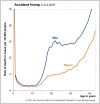(Press-News.org) A new lower-limb prosthetic developed at Vanderbilt University allows amputees to walk without the leg-dragging gait characteristic of conventional artificial legs.
The device uses the latest advances in computer, sensor, electric motor and battery technology to give it bionic capabilities: It is the first prosthetic with powered knee and ankle joints that operate in unison. It comes equipped with sensors that monitor its user's motion. It has microprocessors programmed to use this data to predict what the person is trying to do and operate the device in ways that facilitate these movements.
"When its working, it's totally different from my current prosthetic," said Craig Hutto, the 23-year-old amputee who has been testing the leg for several years. "A passive leg is always a step behind me. The Vanderbilt leg is only a split-second behind."
The bionic leg is the result of a seven-year research effort at the Vanderbilt Center for Intelligent Mechatronics, directed by Michael Goldfarb, the H. Fort Flowers Professor of Mechanical Engineering. The project was initially funded by a seed grant from the National Science Foundation, followed by a development grant from the National Institutes of Health. Key aspects of the design have been patented by the university, which has granted exclusive rights to develop the prosthesis to Freedom Innovations, a leading developer and manufacturer of lower limb prosthetic devices.
"With out latest model, we have validated our hypothesis that the right technology was available to make a lower-limb prosthetic with powered knee and ankle joints," said Goldfarb. "Our device illustrates the progress we are making at integrating man and machine."
The Vanderbilt prosthesis is designed for daily life. It makes it substantially easier for an amputee to walk, sit, stand, and go up and down stairs and ramps. Studies have shown that users equipped with the device naturally walk 25 percent faster on level surfaces than when they use passive lower-limb prosthetics. That is because it takes users 30 to 40 percent less of their own energy to operate.
"Going up and down slopes is one of the hardest things to do with a conventional leg," said Hutto. "So I have to be conscious of where I go because I can get very tired walking up an down slopes. But that won't be a problem with the powered leg because it goes up and down slopes almost like a natural leg."
Recent technological advances have allowed the Vanderbilt engineers to produce a device that weighs about nine pounds – less than most human lower legs – and can operate for three days of normal activity, or 13 to 14 kilometers of continuous walking, on a single charge. They have also dramatically reduced the amount of noise that the latest model makes, although it is slightly louder than they would like.
One of the latest capabilities that the engineers have added is an anti-stumble routine. If the leg senses that its user is starting to stumble, it will lift up the leg to clear any obstruction and plant the foot on the floor.
In order to incorporate all the improvements, the prosthetic's hardware design has gone through seven versions and its electronics board has been redone 15 times.
According to Goldfarb, it was tough to make the prosthetic light and quiet enough. In particular, it was difficult to fit the powerful motors and drive train that they needed into the volume available. The biggest technical challenge, however, was to develop the control system.
"As you add greater capability, you are also adding greater liability," he said. "Not only does the controller have to perform individual operations reliability, but it has to perform several operations at the same time and not get confused."
INFORMATION:
The Center for Intelligent Mechatronics is also developing an anthropomorphic prosthetic arm project and an advanced exoskeleton to aid in physical therapy.
Visit Research News @ Vanderbilt for more research news from Vanderbilt.
New 'bionic' leg gives amputees a natural gait
First prosthetic with powered knee and ankle joints
2011-08-19
ELSE PRESS RELEASES FROM THIS DATE:
Robust preschool experience offers lasting effects on language and literacy
2011-08-19
Preschool teachers' use of sophisticated vocabulary and analytic talk about books combined with early support for literacy in the home can predict fourth-grade reading comprehension and word recognition, new research from Vanderbilt University's Peabody College finds.
The findings, published in Child Development and included in a review article in the August 19, 2011 edition of Science, present evidence that there are lasting, complex and mutually reinforcing effects that flow from strong early childhood classrooms.
"We need to take very seriously the importance ...
Parents misled by advocates of single-sex education
2011-08-19
There is no scientific basis for teaching boys and girls separately, according to Lise Eliot from The Chicago Medical School. Her review reveals fundamental flaws in the arguments put forward by proponents of single-sex schools to justify the need of teaching teach boys and girls separately. Eliot shows that neuroscience has identified few reliable differences between boys' and girls' brains relevant to learning or education. Her work is published online in Springer's journal Sex Roles.
The first issue Eliot highlights is that single-sex school advocates often claim differences ...
Treatment with vitamin C dissolves toxic protein aggregates in Alzheimer's disease
2011-08-19
Researchers at Lund University have discovered a new function for vitamin C. Treatment with vitamin C can dissolve the toxic protein aggregates that build up in the brain in Alzheimer's disease. The research findings are now being presented in the Journal of Biological Chemistry.
The brains of people with Alzheimer's disease contain lumps of so-called amyloid plaques which consist of misfolded protein aggregates. They cause nerve cell death in the brain and the first nerves to be attacked are the ones in the brain's memory centre.
"When we treated brain tissue from ...
Are those liquids explosive?
2011-08-19
A team of researchers from the University of the Basque Country (Spain) has developed a method to determine the chemical composition of liquids seized by police and suspected to be explosive. Some of the samples analysed contained substances hazardous to health, such as methanol and boric acid.
Each year police forces seize tonnes of pyrotechnic substances which, in principle, are for indoor firework manufacturing (i.e. flares or those used in artistic or sporting events), but which also may end up in the hands of violent groups and hooligans.
A group of chemists from ...
Revealed: How sticky egg captures sperm
2011-08-19
Researchers have uncovered exactly how a human egg captures an incoming sperm to begin the fertilisation process, in a new study published this week in the journal Science.
The research identifies the sugar molecule that makes the outer coat of the egg 'sticky', which is vital for enabling the sperm and egg to bind together. Researchers across the world have been trying to understand what performs this task for over thirty years.
The scientists behind this study believe their work could help address some of the previously unexplained causes of human infertility and ...
CSHL neuroscientists show activity patterns in fly brain are optimized for memory storage
2011-08-19
Large-scale imaging shows mushroom body activity patterns are sparse and randomly distributed Cold Spring Harbor, NY – We know from experience that particular smells are almost inseparable in our minds with memories, some vague and others very specific. The smell of just-baked bread may trigger an involuntary mental journey, even if for a moment, to childhood, or to a particular day during childhood. Or it may, more diffusely, remind someone of grandma. How are these associations forged in the brain and how do we remember them? A research team at Cold Spring Harbor ...
Boys reach sexual maturity younger and younger
2011-08-19
This release is available in German.
Boys are maturing physically earlier than ever before. The age of sexual maturity has been decreasing by about 2.5 months each decade at least since the middle of the 18th century. Joshua Goldstein, director of the Max Planck Institute for Demographic Research in Rostock (MPIDR), has used mortality data to prove this trend, which until now was difficult to decipher. What had already been established for girls now seems to also be true for boys: the time period during which young people are sexually mature but socially not yet considered ...
Study raises doubts about value of heart ultrasound before elective surgery
2011-08-19
TORONTO, Ont., Aug. 18, 2011_A new study has found no evidence that patients who had a heart ultrasound known as an echocardiogram before major surgery had improved survival rates one month or one year after their operation.
Some groups of patients actually had worse survival rates, according to Dr. Duminda Wijeysundera, a scientist at the Li Ka Shing Knowledge Institute of St. Michael's Hospital and the Institute for Clinical Evaluative Sciences.
His study, published in the British Medical Journal, adds to a growing body of evidence that echocardiograms may not be ...
UGA physicist helps uncover new data on adenine, a crucial building block of life
2011-08-19
Athens, Ga. – Early Earth's atmosphere provided little shielding for ultraviolet light from space, so many prebiotic molecules, bombarded by it and light of other wavelengths, had a hard time surviving at all. But some molecules became photostable—able to withstand the assault and thrive as building blocks of life.
Five of the many molecules that survived the bombardment from UV light were the nucleic acid bases adenine, cytosine, guanine, thymine and uracil. Now, in just published research, a University of Georgia physicist and a collaborator in Germany have shown that ...
Study finds sex differences in mental illness
2011-08-19
WASHINGTON – When it comes to mental illness, the sexes are different: Women are more likely to be diagnosed with anxiety or depression, while men tend toward substance abuse or antisocial disorders, according to a new study published by the American Psychological Association.
Published online in APA's Journal of Abnormal Psychology, the study looked at the prevalence by gender of different types of common mental illnesses. The researchers also found that women with anxiety disorders are more likely to internalize emotions, which typically results in withdrawal, loneliness ...
LAST 30 PRESS RELEASES:
Sports injuries sustained during your period might be more severe
World's first successful 2 Tbit/s free-space optical communication using small optical terminals mountable on satellites and HAPS
Can intimate relationships affect your heart? New study says ‘yes’
Scalable and healable gradient textiles for multi‑scenario radiative cooling via bicomponent blow spinning
Research shows informed traders never let a good climate crisis go to waste
Intelligent XGBoost framework enhances asphalt pavement skid resistance assessment
Dual-function biomaterials for postoperative osteosarcoma: Tumor suppression and bone regeneration
New framework reveals where transport emissions concentrate in Singapore
NTP-enhanced lattice oxygen activation in Ce-Co catalysts for low-temperature soot combustion
Synergistic interface engineering in Cu-Zn-Ce catalysts for efficient CO2 hydrogenation to methanol
COVID-19 leaves a lasting mark on the human brain
Scientists use ultrasound to soften and treat cancer tumors without damaging healthy tissue
Community swimming program for Black youth boosts skills, sense of belonging, study finds
Specific depressive symptoms in midlife linked to increased dementia risk
An ‘illuminating’ design sheds light on cholesterol
Who is more likely to get long COVID?
Study showcases resilience and rapid growth of “living rocks”
Naval Research Lab diver earns Office of Naval Research 2025 Sailor of the Year
New Mayo-led study establishes practical definition for rapidly progressive dementia
Fossil fuel industry’s “climate false solutions” reinforce its power and aggravate environmental injustice
Researchers reveal bias in a widely used measure of algorithm performance
Alcohol causes cancer. A study from IOCB Prague confirms damage to DNA and shows how cells defend against it
Hidden viruses in wastewater treatment may shape public health risks, study finds
Unlock the power of nature: how biomass can transform climate mitigation
Biochar reshapes hidden soil microbes that capture carbon dioxide in farmland
Reducing saturated fat intake shows mortality benefit, but only in high-risk individuals
Manta rays create mobile ecosystems, study finds
Study: Mixed results in using lipoic acid to treat progressive multiple sclerosis
Norbert Holtkamp appointed director of Fermi National Accelerator Laboratory
New agentic AI platform accelerates advanced optics design
[Press-News.org] New 'bionic' leg gives amputees a natural gaitFirst prosthetic with powered knee and ankle joints



